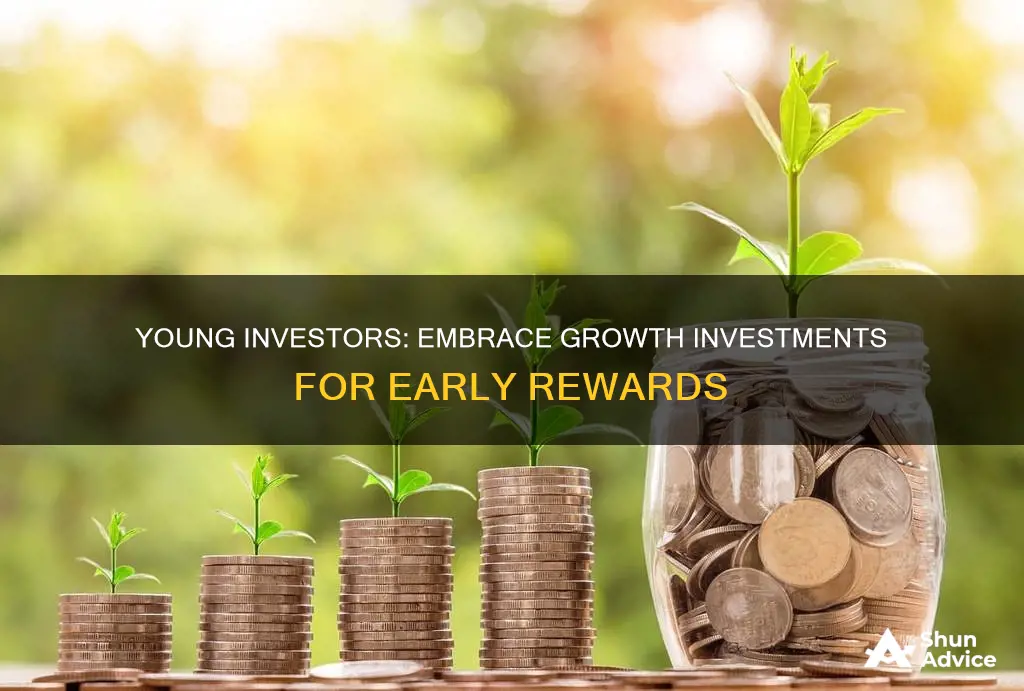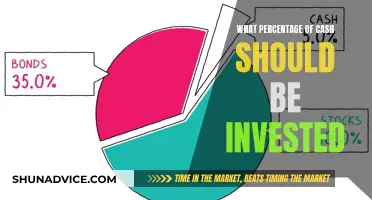
There are several benefits to starting a growth investment plan early in life. Young people have the advantage of time, which allows them to take advantage of compounding—the ability to grow an investment by reinvesting earnings. This means that even a small amount of money invested at a young age can grow into a substantial sum over time. For example, a $10,000 investment at 20 years old can grow to over $70,000 by the time the investor turns 60. Additionally, young investors can afford to take more risks with their investment portfolios since they have more time to recover from potential losses. They also have the flexibility to study investing strategies and learn from their mistakes. Starting early can also help establish good financial habits and build long-term wealth.
| Characteristics | Values |
|---|---|
| Time | The longer your money is invested, the more it will grow. |
| Compounding | Compounding allows your investments to grow by reinvesting the earnings. |
| Risk | Younger investors can afford to take more risks and have time to recover from losses. |
| Financial habits | Investing encourages better financial habits and discourages reckless spending. |
| Flexibility | Young investors have the time and flexibility to study investing and learn from their mistakes. |
| Technology | Tech-savvy young investors can take advantage of online tools and trading platforms. |
What You'll Learn

The impact of compounding
Compounding is a powerful concept in investing that can significantly benefit individuals who start investing at a young age. It involves earning returns not just on the original investment but also on the returns generated from previous periods. This process, known as "compound interest," creates a snowball effect, where both the original investment and the accumulated interest grow together, leading to exponential growth over time.
Here's an example to illustrate the impact of compounding: Let's say you invest $1,000 and earn a 6% rate of return in the first year. Your total investment at the end of the year would be $1,060, including the $60 return. In the second year, you earn a 6% return on the new total of $1,060, resulting in $63.60, bringing your investment to $1,123.60. This process continues, and over time, your annual earnings will grow exponentially.
Compounding is particularly advantageous for young investors because it provides the benefit of time. The earlier an individual starts investing, the longer their money has to compound and grow. For example, if you invest $5,000 per year for 40 years at a 6% annual return, you will accumulate a significant sum due to the power of compounding. Moreover, investing young allows individuals to take on more risk, as they have a longer time horizon and can recover from potential losses.
To maximize the impact of compounding, it is essential to reinvest returns back into the investment account. Additionally, starting with a higher initial amount and achieving higher investment returns will accelerate the compounding process. Compounding can be applied to various investment vehicles, such as stocks, mutual funds, or retirement accounts like 401(k)s and IRAs.
In conclusion, compounding has a profound impact on investment growth, especially for those who start early in their careers. By reinvesting returns, taking advantage of time, and utilizing appropriate investment vehicles, young investors can harness the power of compounding to build substantial wealth over time.
Securities Sales: Investment Activity or Cash Flow?
You may want to see also

Higher risk tolerance
Investing when you're young can mean you have a higher risk tolerance, which can lead to higher returns. This is because you have a longer time horizon, meaning more time to recover if things go wrong.
As a young investor, you have years of earning ahead of you, and retirement is likely a long way off. This means you can afford to take on more risk in your investment activities and build a more aggressive portfolio. You can explore higher-risk investments such as cryptocurrency, private equity, or stocks, which have historically provided the highest average rate of return.
The longer time horizon also means that if you make a mistake, you have more time to bounce back and recover any losses. For example, if you invest $10,000 at a 5% interest rate at age 20, it would grow to over $70,000 by the time you're 60. However, if you were to make the same investment at age 30, it would only yield about $43,000 by age 60.
Another benefit of higher-risk investments when you're young is that you can still see returns even if you invest when the market is at an all-time high. The stock market has historically always recovered from recessions and corrections and continued to trend upward.
However, it's important to remember that while taking on more risk can lead to higher returns, it also increases your chances of losing your money. Therefore, it's crucial to do your research, diversify your portfolio, and invest responsibly.
Recording Cash Investments: A Step-by-Step Guide for Beginners
You may want to see also

Building better financial habits
Starting to invest early in life is a great way to build better financial habits. Here are some reasons why:
Time is on Your Side
As a young investor, you have time on your side. This means that any money you invest now has more time to grow before you need it. The power of compounding, or reinvesting your earnings, means that even a small amount invested when you're young can grow significantly over time. This is often referred to as "the eighth wonder of the world" by none other than Albert Einstein himself.
Building Better Habits
Focusing on investing can help curb reckless spending habits. Taking the time to research and carefully invest will make you more aware of your income and expenses. You'll start asking yourself: is it better to spend this money now or put it towards my future?
Taking Calculated Risks
When you're young, you're in a better position to take on more risk with your investments. You have more time to recover if things don't go as planned, and you can afford to be more aggressive with your investment strategies. This is not to say that you should throw caution to the wind, but rather take calculated risks and have realistic expectations.
Learning and Refining
Investing is a great way to learn about the markets and refine your strategies over time. There will be a learning curve, and making mistakes when you're young gives you the opportunity to bounce back and correct course. You can also leverage your tech-savviness to navigate trading apps and online investing tools to make informed decisions.
Long-Term Wealth Building
Investing is a great way to build long-term wealth. Even if you have to start small, starting early gives your investments time to grow and compound. This can set you up for a more comfortable financial future and help you achieve your financial goals.
Remember, it's important to invest responsibly and ensure you have a financial cushion for emergencies before putting a large amount of money into any investment. Building better financial habits is a journey, and starting early gives you a head start towards a brighter financial future.
Cash is Not King: Exploring Investment Alternatives
You may want to see also

The power of time
When it comes to investing, time is a crucial factor, and starting early in your career can provide distinct advantages. The earlier you invest, the more time your money has to grow and compound, which can make a significant difference in the long run. This concept is often referred to as "time in the market," highlighting that it is the duration of your investment, rather than the timing of entering the market, that matters most.
The impact of time is best illustrated through the power of compounding. Compounding occurs when you reinvest your earnings, and those earnings generate further returns. Over time, this process can lead to significant wealth accumulation. For example, a $10,000 investment at a 5% interest rate will grow to over $70,000 over 40 years, but if you start 10 years later, that same investment will only yield about $43,000. The longer your investment horizon, the more time your money has to compound and grow.
Time also allows young investors to take on more risk. With a longer time horizon, young people can afford to be more aggressive in their investment strategies and explore higher-risk, higher-return opportunities. If an investment fails or the market becomes volatile, younger investors have the advantage of time to recover and bounce back. This ability to weather risks and market downturns is a significant benefit of investing early.
Additionally, time provides young investors with the opportunity to build better financial habits. By starting early, you develop good savings habits and a disciplined approach to investing. You become more conscious of your spending and develop a long-term mindset, which can benefit your overall financial well-being.
Time is a valuable resource for young investors. It allows your investments to grow, provides the ability to take calculated risks, and fosters the development of positive financial habits. By investing early and giving your money time to work for you, you can harness the power of time to build substantial wealth over the long term.
Qapital Invest: A Guide to Getting Started and Growing Wealth
You may want to see also

Tax-free growth
Investing when you're young is a great way to build wealth and plan for your future, especially with the benefit of tax-free growth. Here are some ways to achieve tax-free growth through investing:
K) and 403(b) Plans
A 401(k) is a retirement plan offered by employers, allowing you to invest on a tax-deferred basis. This means you don't pay taxes on the money you invest until you withdraw it. Some companies may even match your contributions, boosting your retirement savings. A 403(b) plan is similar but is offered to educators, public employees, and employees of nonprofits.
Traditional IRA and Roth IRA
Individual Retirement Accounts (IRAs) are another great option for tax-free growth. There are two types: Traditional IRAs and Roth IRAs. Traditional IRAs are tax-deferred, meaning you contribute pre-tax dollars that grow tax-free. You only pay taxes when you withdraw the money. On the other hand, Roth IRAs use after-tax money, but you can make tax-free withdrawals in retirement.
Health Savings Account (HSA)
A Health Savings Account (HSA) is a great option for tax-conscious investors. It allows you to save for medical expenses while also providing tax benefits. Contributions are made with pre-tax dollars, which can be tax-deductible, and the interest earned is tax-deferred. You can make tax-free withdrawals for eligible medical expenses.
Municipal Bonds
Municipal bonds, often called "munis," are generally safe investments backed by government entities. They offer potential tax exemptions on federal, state, and city taxes, depending on the bond and your location. However, not all municipal bonds are tax-exempt, so careful research is necessary.
Tax-Free Exchange-Traded Funds (ETFs)
Exchange-Traded Funds (ETFs) are known for their low costs and flexibility. The tax benefits depend on the types of bonds held by the ETF. For example, US government bond ETFs may be exempt from local and state taxes but are subject to federal tax.
529 Education Fund
A 529 education plan allows you to save for school tuition and higher education expenses. While contributions are made with after-tax dollars, distributions for eligible college costs may be tax-free at the federal level and in some states. However, using the money for non-qualified expenses will incur income tax and penalties.
Is Building Purchase with Cash an Investment Strategy?
You may want to see also
Frequently asked questions
Investing when you're young gives your money more time to compound as you reinvest your earnings. You can take on more risk with your investments when you're young because you have more time to recover if things go wrong.
Compounding occurs when you reinvest your earnings, and those earnings begin to work for you. They earn you more money. This allows you to invest less each month from an early age to end up with the same amount during retirement, if not more.
Stocks are among the riskier investments available, but you'll have more time to bounce back if you start investing young. Stocks have historically provided the highest average rate of return.
It's important to invest responsibly. If you have high-cost debt (like credit card debt), you should tackle that first before putting a large amount of money into any investment. In addition, it's a good idea to build a financial cushion you can fall back on in emergencies.
Nearly every state has a college savings plan that allows you to put money away for higher education. These funds can be allocated among various investment choices and will grow tax-free until they're withdrawn to pay for qualified higher education expenses.







